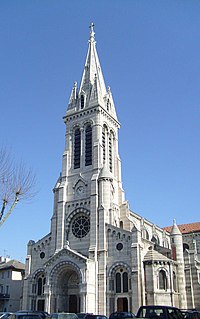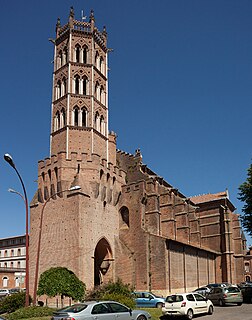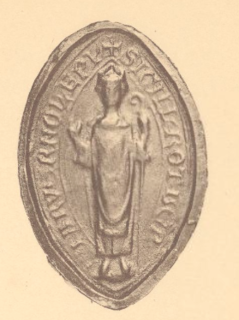
Gordes is a commune in the Vaucluse département in the Provence-Alpes-Côte d'Azur region in southeastern France. The residents are known as Gordiens. The nearest big city is Avignon; smaller cities nearby include Cavaillon, L'Isle-sur-la-Sorgue and Apt.
Eustace I Granier, also known as Eustace Grenier or Eustace Garnier, called in Latin Eustachius Granarius in the charters, was a Flemish crusader who took part in the First Crusade. He became lord of Caesarea in 1101 and lord of Sidon in 1110. On 18 April 1123, he was elected constable and bailiff of Jerusalem during the captivity of Baldwin II of Jerusalem. Shortly before his death, he defeated a Fatimid army at the Battle of Yibneh near Ibelin.
Eustace Grenier is quoted in a text in verse written during his life in honour of the knights of the diocese of Thérouanne who accompanied Baldwin of Boulogne to the Holy Land.
Contemporary authors and historians identify Eustace Grenier as a nobleman from the diocese of Thérouanne in the County of Saint-Pol. Alan V. Murray, historian of the Crusades, writes: "However, his origins can be established with a high degree of certainty. The Versus de viris illustribus diocesis Tarvanensis qui in sacra fuere expeditione identifies him as a Fleming from the diocese of Therouanne".

The Diocese of Gap and Embrun is a Latin Church ecclesiastical territory or diocese of the Catholic Church in Provence-Alpes-Côte d'Azur region of Southern France.

The Diocese of Digne is a Latin Church ecclesiastical territory or diocese of the Catholic Church in France. Erected in the 4th century as the Diocese of Digne, the diocese has been known as the Diocese of Digne–Riez–Sisteron since 1922. The diocese comprises the entire department of Alpes-de-Haute-Provence, in the Region of Provence-Alpes-Côte d'Azur. The diocese was a suffragan diocese of the Archdiocese of Aix-en-Provence and Arles until 2002 and is now a suffragan diocese in the ecclesiastical province of the metropolitan Archdiocese of Marseille. The Bishop of Digne's cathedra is found in Digne Cathedral at the episcopal see of Digne-les-Bains.

Saignon is a commune in the Vaucluse department in the Provence-Alpes-Côte d'Azur region in southeastern France. The nearest town is Apt.

The Lords of Coucy, also spelt Couci, were a medieval lordship based on the barony of Coucy located in the current commune of Coucy-le-Château-Auffrique, Picardy. The château de Coucy was founded by Hervé, archbishop of Rheims, and remained under the fluctuating control of these archbishops for some time until probably the later part of the 10th century. The exact status of Coucy becomes obscure for nearly a century before the emergence of Lord Aubrey, Earl of Northumbria. Though the Lords of Coucy were entitled to the title of baron, they preferred the rarer Sire.

The Roman Catholic Diocese of Le Puy-en-Velay is a diocese of the Latin Rite of the Roman Catholic Church in France. The diocese comprises the whole department of Haute-Loire, in the Region of Auvergne-Rhône-Alpes. Currently the diocese is a suffragan of the Archdiocese of Clermont. Last bishop, as of April 2015 was bishop Luc Crépy. Actually is bishop in Versailles, Since February 2021. The current bishop, as of March 2022 is Yves Baumgarten.

Agathe de Rambaud was born in Versailles as Agathe-Rosalie Mottet and was baptized in the future cathedral Saint-Louis of Versailles, on 10 December 1764. She died in Aramon, in the département of Gard, on 19 October 1853. She was the official nurse of the royal children, and particularly in charge of the Dauphin from 1785 to 1792.
Étienne de Bar, sometimes Stephen of Bar, was a French cardinal and nephew of Pope Calixtus II.

The Roman Catholic Archdiocese of Clermont is an Archdiocese of the Latin Rite of the Roman Catholic Church in France. The diocese comprises the department of Puy-de-Dôme, in the Region of Auvergne. The Archbishop's seat is Clermont-Ferrand Cathedral. Throughout its history Clermont was the senior suffragan of the Archdiocese of Bourges. It became a metropolitan see itself, however, in 2002. The current archbishop is François Kalist.

The former French Catholic diocese of Apt, in southeast France, existed from the fourth century until the French Revolution. By the Concordat of 1801, it was suppressed, and its territory was divided between the diocese of Digne and the diocese of Avignon. Its seat was at Apt Cathedral, in Vaucluse.

The Roman Catholic Diocese of La Rochelle and Saintes is a diocese of the Latin Rite of the Catholic Church in France. The diocese comprises the département of Charente-Maritime and the French overseas collectivity of Saint-Pierre and Miquelon. The bishop is a suffragan of the Archbishop of Bordeaux. The episcopal seat is in La Rochelle Cathedral. Saintes Cathedral is a co-cathedral.

The Roman Catholic Diocese of Pamiers, Couserans, and Mirepoix is a diocese of the Latin Rite of the Roman Catholic Church in southern France. The diocese comprises the department of Ariège and is suffragan to the Archdiocese of Toulouse. The diocese of Pamiers is divided into five Deaneries: Pamiers, Foix, Haut-Ariège, Couserans, and Pays-d'Olmes-Mirapoix. The episcopal see is the Cathedral of Saint Antoninus in the city of Pamiers, and the current bishop is Jean-Marc Eychenne, appointed on 17 December 2014.

The Roman Catholic Diocese of Montauban is a diocese of the Latin Rite of the Roman Catholic Church in France. The diocese is coextensive with Tarn-et-Garonne, and is currently a suffragan of the Archdiocese of Toulouse. The episcopal seat of the Diocese of Montauban is in Montauban Cathedral.

Pierre Aycelin de Montaigut or Montaigu, Montagu, known as Cardinal de Laon, born between 1320 and 1325 and died 8 November 1388, was a fourteenth-century French cardinal, who was the bishop of Nevers (1361–1371) and bishop of the Diocese of Laon (1371-1386), advisor to the king of Charles V and peer of France.

The Fort Saint-André is a medieval fortress in the commune of Villeneuve-lès-Avignon in the Gard département of France, dating from the first half of the 14th century.

Gaillard de La Mothe was a fourteenth-century prelate and Cardinal, of Gascon extraction. Gaillard was born towards the end of the 13th century, either in Toulouse or Bordeaux, and died in Avignon on 20 December 1356. He was the son of Amanieu Levieux de La Motte, seigneur of Roquetaillade. His mother was Elips (Alix) de Got, daughter of Arnaud-Garsale de Got, brother of Bertrand de Got. He was therefore a nephew of Pope Clement V. Gaillard had a brother, Bertrand. Another uncle, his father's brother, Guillaume de la Mothe, was Bishop of Bazas from 1303-1313, when he was transferred to Saintes, and again from 1318 to 1319.

Robert of Auvergne, also called Robert de la Tour, was a French nobleman, prelate and poet from the Auvergne. He served as bishop of Clermont from 1195 until 1227 and thereafter as archbishop of Lyon until his death. He was also a troubadour, composing poetry in Occitan.
Rostang of Arles was Archbishop of Arles from 870 to 913. He supported the coup d'état of Boso of Provence against the Carolingians in 879.

Laugier of Nice, known as the Roux, is also known as Laugier of Orange-Mévouillon or Laugier of Vence. He was co-lord of Nice, Gréolières, Cagnes and Vence. He held these titles in part through his wife Odile of Provence and his father-in-law, William I of Provence. Laugier seems to be related to the Mévouillon-Orange lineage. Some historians give him the title of viscount. He was a member of the first house of the counts of Orange-Nice. From 1023 Laugier was a monk of the order of Cluny.

















